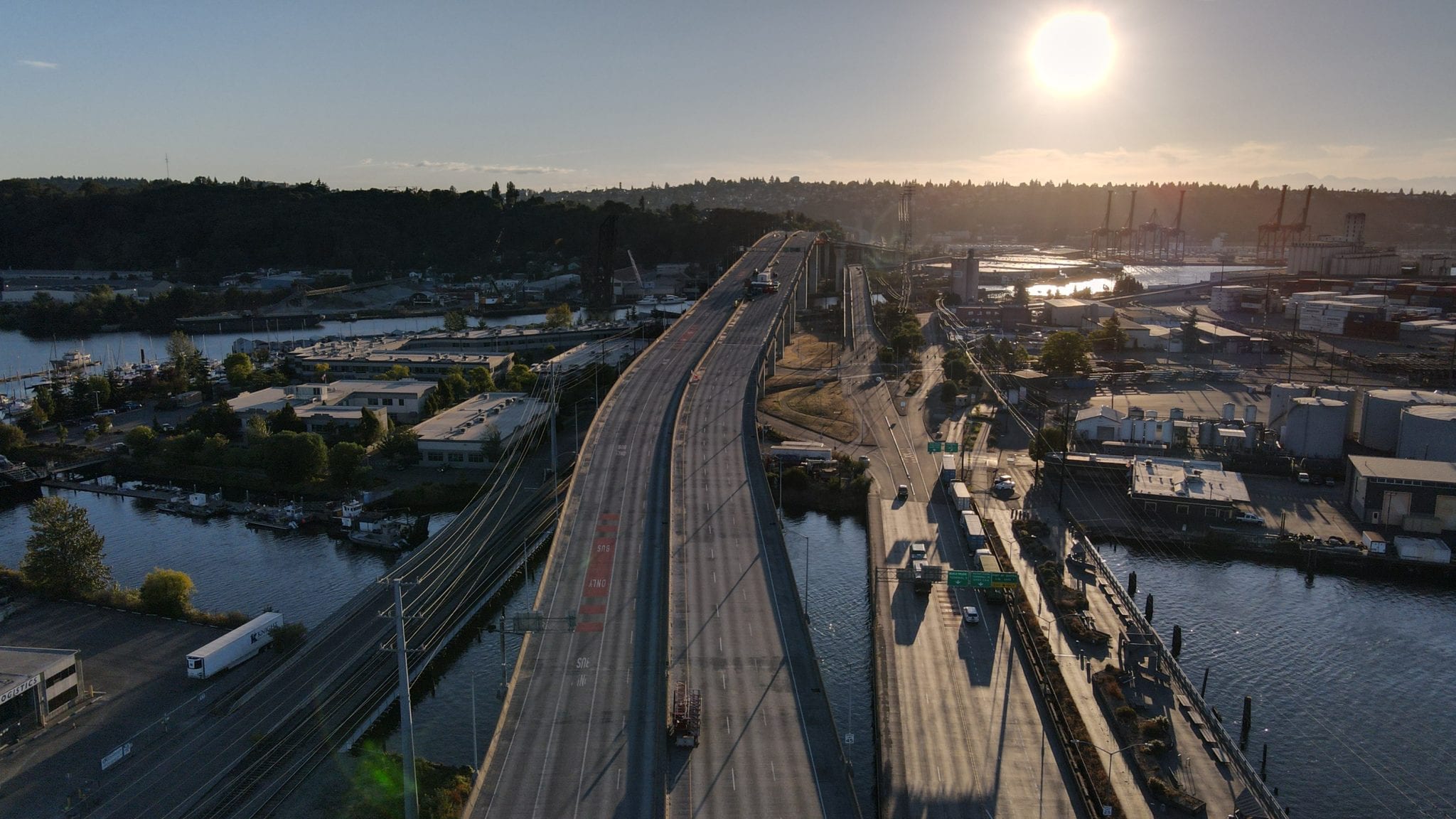 West Seattle Bridge at sunset. Photo Credit: Madison Linkenmeyer
West Seattle Bridge at sunset. Photo Credit: Madison Linkenmeyer Every Monday, we’re posting a blog to keep you informed about our progress to stabilize the bridge, our efforts to address traffic and mobility, and other items related to the West Seattle High-Rise Bridge closure.
In this week’s update:
- High-Rise Bridge Stabilization Update
- Cost-Benefit Analysis to Inform Repair-or-Replace Decision
- Low Bridge Automated Enforcement & Sign Installation
- This Week’s West Seattle Bridge Community Task Force Meeting (watch using this link)
- Vegetation Work at SW Roxbury St and Olson Pl SW
- Upcoming Community Outreach
West Seattle High-Rise Bridge Stabilization
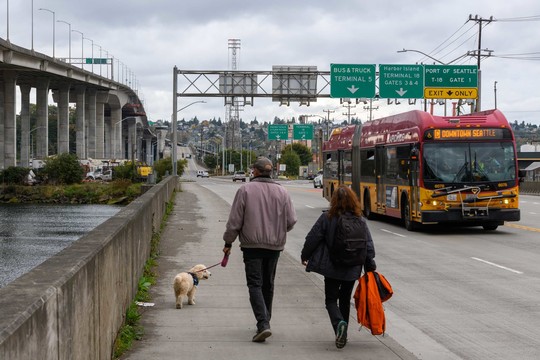
Stabilizing the High-Rise Bridge is necessary to preserve public safety and the integrity of the bridge so that all options remain on the table with the approaching repair or replace decision. Stabilization puts us on the right path if repair is determined to be the best option and helps prevent further crack growth. Stabilization is also necessary for safe demolition if we choose to replace the bridge.
Kraemer North America, our contractor for the stabilization work, is working every week, Monday through Saturday from 6 AM to 4:30 PM, to stabilize the bridge. They also worked this Sunday, October 25 from 6 AM to 6 PM. The Low Bridge remained open this weekend and will remain open throughout the stabilization work. We expect to complete stabilization work by the end of this year.
Photo Gallery: Recent Stabilization Work
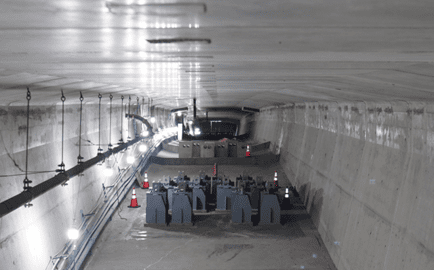
The girder interior with the brackets where post-tensioning will be anchored, with deviator blocks through which the strands will run in the background.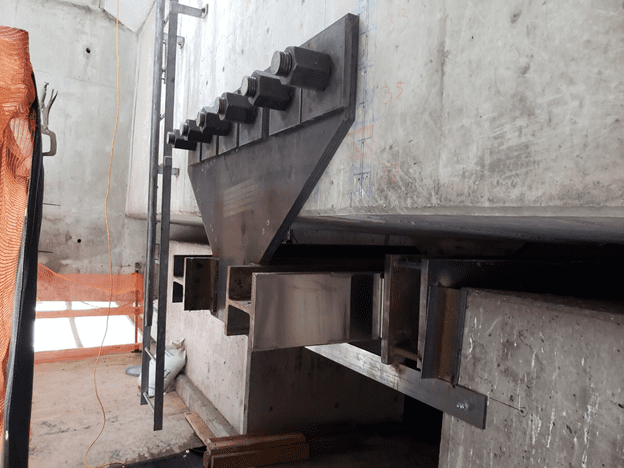
The installation of the temporary Pier 18 brace is 80% complete.
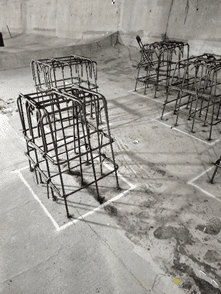
Two weeks ago, we showed you the “forms” for the deviator blocks, which prevent post-tensioning strands from touching the bottom of the girder. 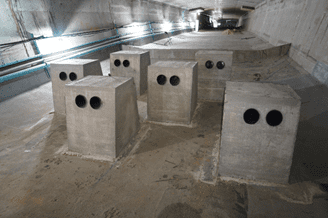
Now you can see the final product, ready for the ducts and tendons to be threaded through.
The table below provides details on recent and upcoming West Seattle Bridge-related work:
| Recent and Upcoming Work | Details |
|---|---|
| The stabilization work we expect to be complete by the end of the year includes: | Carbon fiber wrapping weakened areas of the bridge, adding post-tensioning inside the girders, and injecting epoxy into cracks wider than 0.3mm. (The epoxy injections don’t stabilize the bridge; they help prevent further deterioration by protecting the post-tensioning steel inside from corrosion.) Monitoring and inspection activities will continue after stabilization work is complete, in both the repair and replacement scenarios. |
| This coming week, the contractor is planning to: | Finish installing the post-tensioning system; perform the Pier 18 release; and begin constructing a new bearing for Pier 18. |
| During daily work, you will see: | Some crews working on top and under the bridge, as well as scaffolding and crews working on platforms suspended under the bridge. You may also see large equipment and vehicles delivering, moving, and storing materials. |
| There is work taking place inside the bridge that you will not be able to see, including: | Monitoring cracks and installing the additional post-tensioning strands. |
| Upcoming work includes: | After the Pier 18 release and post-tensioning are complete, Kraemer North America will do other stabilization work including applying final layers of CFRP to the girders and rebuilding the Pier 18 bearing. Once all stabilization work has been finished, we will lower the work platforms onto barges. This will likely be in late November or early December. |
| In the coming weeks: | The Mayor will make a final determination as to whether we will move forward with repairing the current bridge or replacing it with a new structure. With our replacement consultant HNTB on board, we are ready to pivot to designing the demolition and replacement structure. |
| Over the past few weeks, we have: | Poured concrete for the deviator blocks, which will keep the post-tensioning strands from touching the bottom of the girder as they travel between anchor locations; installed the post-tensioning brackets; begun Pier 18 work; and continued monitoring and inspection efforts. |
| Since we closed the bridge in March, we have: | Installed an intelligent monitoring system to better understand what type of stabilization and repairs would be needed and to monitor the bridge during this work; designed and started to install stabilization measures; built and hoisted custom work platforms; completed the first phase of carbon fiber wrapping; and completed the cost-benefit analysis (CBA) that will help inform the decision to repair or replace the bridge. |
Traffic Impacts:
While we do not anticipate significant impacts to traffic below the bridge, you may see some traffic control signs and devices. These signs and devices are meant to keep the workers and traveling public safe. Please obey the signs and do not move them.
While the majority of the traveling public will see little to no traffic impacts during Pier 18 work, there may be lane reductions on Klickitat Ave SW and SW Klickitat Way on the west and south sides of Harbor Island. Please obey the traffic control signs and devices and do not attempt to move them. Our teams are coordinating closely with the Port of Seattle to mitigate traffic impacts.
Cost-Benefit Analysis to Inform Repair or Replace Decision
In the coming weeks, Mayor Durkan will share direction on the path forward that provides the safest, fastest solution to reconnect West Seattle, with the highest degree of certainty and lowest level of impact to communities in and around the Duwamish Valley, the city, region, and state. This cost-benefit analysis will play an important role in that decision, along with input from the Technical Advisory Panel (TAP), the West Seattle Bridge Community Task Force (CTF), and SDOT’s leadership, as well as funding options and other external factors at the city, state, and federal level.
As part of our steadfast commitment to clear communication and transparency, we shared the West Seattle High-Rise Bridge Cost-Benefit Analysis (CBA) on Tuesday, October 21. The West Seattle Bridge Community Task Force reviewed and discussed the CBA on Wednesday, October 21. You can watch that meeting here.
The CBA is a dense, technical document, so we’ve provided a “Reader’s Guide” in this blog.
Low Bridge Automated Enforcement coming soon; sign installation began Oct. 24.

When the West Seattle High-Rise Bridge closed on March 23, we also had to restrict access to the Low Bridge – a critical detour route for many. We’ve been adjusting our Low Bridge Access Policy since then to safely accommodate additional users. Starting early December, automated enforcement will now allow us to optimize Low Bridge usage because we can tailor access for different groups of users at different times or on different days of the week.
Automated enforcement on the Low Bridge allows us to better enforce the Low Bridge access policy by recognizing in real-time authorized users like transit vehicles, school buses, freight vehicles, emergency response vehicles, and potentially a small number of additional authorized users, to be identified through the Low Bridge Access Subcommittee.
Read more about automated enforcement in this blog.
Next week’s West Seattle Bridge Community Task Force meeting on October 28 at 12 PM
The West Seattle High-Rise Bridge Community Task Force will hold another virtual meeting Wednesday, October 28, at 12 PM. All Community Task Force meetings are now streamed live on YouTube and we invite you to watch.
Watch the Community Task Force meeting on October 28 at 12 PM.
The meeting will be a follow up after the cost-benefit analysis announcement and continue discussion and Q&A around repair or replace for the High-Rise Bridge.
Vegetation work at SW Roxbury St and Olson Pl SW intersection this past Sunday
This past Sunday, October 25, SDOT crews worked in the medians at the intersection of SW Roxbury St and Olson Pl SW for vegetation trimming, cleanup, and mulching. This work required inside lane closures adjacent to the medians for both eastbound and westbound travel lanes between 8th Ave SW and 2nd Ave SW.
Upcoming Community Outreach
Our outreach team is continuously connecting with the community to gather your input and hear about day-to-day experiences in West Seattle and the Duwamish Valley. Upcoming events include:
- Wednesday, October 28: West Seattle Bridge Community Task Force meeting
- Wednesday, October 28: Highland Park Action Coalition meeting